ignition Citroen DS4 RHD 2013.5 1.G Workshop Manual
[x] Cancel search | Manufacturer: CITROEN, Model Year: 2013.5, Model line: DS4 RHD, Model: Citroen DS4 RHD 2013.5 1.GPages: 400, PDF Size: 31.86 MB
Page 183 of 400

181Safety
Seat belts
Front seat belts
The front seat belts are fitted with a
pretensioning and force limiting system.
This system improves safety in the front
seats in the event of a front or side impact.
Depending on the severity of the impact, the
pretensioning system instantly tightens the seat
belts against the body of the occupants.
The pretensioning seat belts are active when
the ignition is on.
The force limiter reduces the pressure of the
seat belt on the chest of the occupant,
so improving their protection.
Fastening
Pull the strap, then insert the tongue in the
buckle.
Check that the seat belt is fastened
correctly by pulling the strap.
Unfastening
Press the red button on the buckle.
Guide the seat belt as it reels in.
Seat belt not fastened /
unfastened warning lamp in
the instrument panel
When the ignition is switched on,
this warning lamp comes on in the
instrument panel if the driver and/
or the front passenger has not fastened their
seat belt.
From approximately 12 mph (20 km/h)
this warning lamp flashes for two minutes
accompanied by an audible signal of increasing
volume. Once these two minutes have elapsed,
this warning lamp remains on until the driver
and/or the front passenger fastens their seat
belt.
Height adjustment
To lower the attachment point, squeeze the
control A
and slide it downwards.
To raise the attachment point, slide the
control A
upwards.
Page 185 of 400

183Safety
Seat belt unfastened warning
lamp in the instrument panel
This warning lamp comes on in the
instrument panel when one or more rear
passengers unfasten their seat belt.
Seat belt unfastened warning
lamps display
3.
Right hand rear seat belt warning lamp.
4.
Centre rear seat belt warning lamp.
5.
Left hand rear seat belt warning lamp.
When the ignition is switched on, with the
engine running or when the vehicle is moving at
less than 12 mph (20 km/h), the corresponding
warning lamps 3
, 4
and 5
come on in red for
approximately 30 seconds, if the seat belt is not
fastened.
When the vehicle is moving at more than 12 mph
(20 km/h), the corresponding warning lamps 3
,
4
and 5
come on in red, accompanied by an
audible signal and a message in the screen, if a
rear passenger has unfastened their seat belt.
From approximately 12 mph (20 km/h),
this warning lamp flashes for two minutes
accompanied by an audible signal of increasing
volume. Once these two minutes have elapsed,
this warning lamp remains on until the one or
more rear passengers fasten their seat belt.
Page 187 of 400
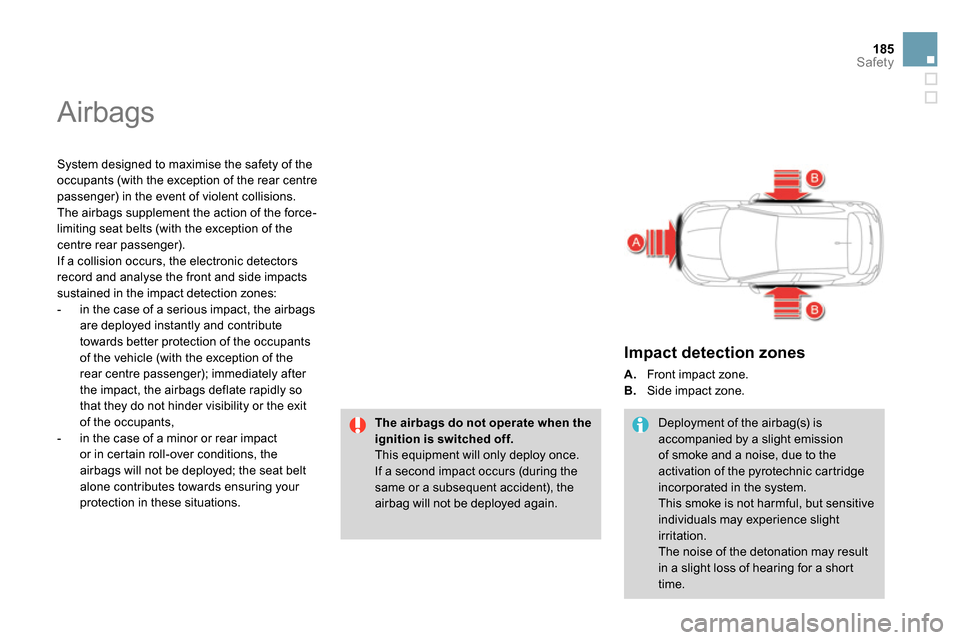
185Safety
Airbags
System designed to maximise the safety of the
occupants (with the exception of the rear centre
passenger) in the event of violent collisions.
The airbags supplement the action of the force-
limiting seat belts (with the exception of the
centre rear passenger).
If a collision occurs, the electronic detectors
record and analyse the front and side impacts
sustained in the impact detection zones:
- in the case of a serious impact, the airbags
are deployed instantly and contribute
towards better protection of the occupants
of the vehicle (with the exception of the
rear centre passenger); immediately after
the impact, the airbags deflate rapidly so
that they do not hinder visibility or the exit
of the occupants,
- in the case of a minor or rear impact
or in certain roll-over conditions, the
airbags will not be deployed; the seat belt
alone contributes towards ensuring your
protection in these situations.
The airbags do not operate when the
ignition is switched off.
This equipment will only deploy once.
If a second impact occurs (during the
same or a subsequent accident), the
airbag will not be deployed again.
Impact detection zones
A.
Front impact zone.
B.
Side impact zone.
Deployment of the airbag(s) is
accompanied by a slight emission
of smoke and a noise, due to the
activation of the pyrotechnic cartridge
incorporated in the system.
This smoke is not harmful, but sensitive
individuals may experience slight
irritation.
The noise of the detonation may result
in a slight loss of hearing for a short
time.
Page 189 of 400

187Safety
Deactivation
Only the passenger's front airbag can be
deactivated:
insert the key in the passenger airbag
deactivation switch,
turn it to the "OFF"
position,
then, remove the key keeping the switch in
the new position.
According to version, this warning
lamp comes on in the instrument
panel and/or in the seat belt and
passenger's front airbag warning lamps display
when the ignition is on and until the airbag is
reactivated. To assure the safety of your child,
the passenger's front airbag must
be deactivated when you install a
"rear facing" child seat on the front
passenger seat.
Other wise, the child would risk being
seriously injured or killed if the airbag
were deployed.
Reactivation
When you remove the child seat, turn the
switch to the "ON"
position to reactivate the
airbag and so assure the safety of your front
passenger in the event of an impact.
With the ignition on, this warning
lamp comes on in the seat belt and
passenger's front airbag warning
lamps display for approximately one
minute, if the passenger's front airbag
is activated.
Operating fault
If this warning lamp comes on in
the instrument panel, contact a
CITROËN dealer or a qualified
workshop to have the system checked. The
airbags may no longer be deployed in the event
of a serious impact.
Page 197 of 400
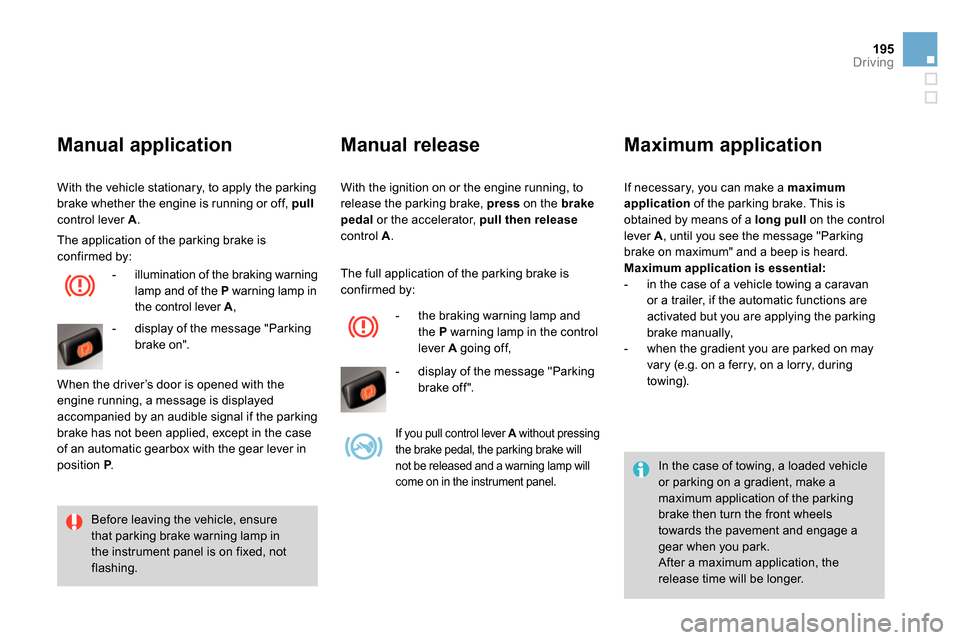
195Driving
With the ignition on or the engine running, to
release the parking brake, press
on the brake
pedal
or the accelerator, pull then release
control A
.
Manual release
Before leaving the vehicle, ensure
that parking brake warning lamp in
the instrument panel is on fixed, not
flashing.
Manual application
With the vehicle stationary, to apply the parking
brake whether the engine is running or off, pull
control lever A
.
The application of the parking brake is
confirmed by:
- illumination of the braking warning
lamp and of the P
warning lamp in
the control lever A
,
- display of the message "Parking
brake on".
When the driver’s door is opened with the
engine running, a message is displayed
accompanied by an audible signal if the parking
brake has not been applied, except in the case
of an automatic gearbox with the gear lever in
position P
. The full application of the parking brake is
confirmed by:
- the braking warning lamp and
the P
warning lamp in the control
lever A
going off,
- display of the message "Parking
brake off ".
If you pull control lever A
without pressing
the brake pedal, the parking brake will
not be released and a warning lamp will
come on in the instrument panel.
Maximum application
If necessary, you can make a maximum
application
of the parking brake. This is
obtained by means of a long pull
on the control
lever A
, until you see the message "Parking
brake on maximum" and a beep is heard.
Maximum application is essential:
- in the case of a vehicle towing a caravan
or a trailer, if the automatic functions are
activated but you are applying the parking
brake manually,
- when the gradient you are parked on may
vary (e.g. on a ferry, on a lorry, during
towing).
In the case of towing, a loaded vehicle
or parking on a gradient, make a
maximum application of the parking
brake then turn the front wheels
towards the pavement and engage a
gear when you park.
After a maximum application, the
release time will be longer.
Page 198 of 400
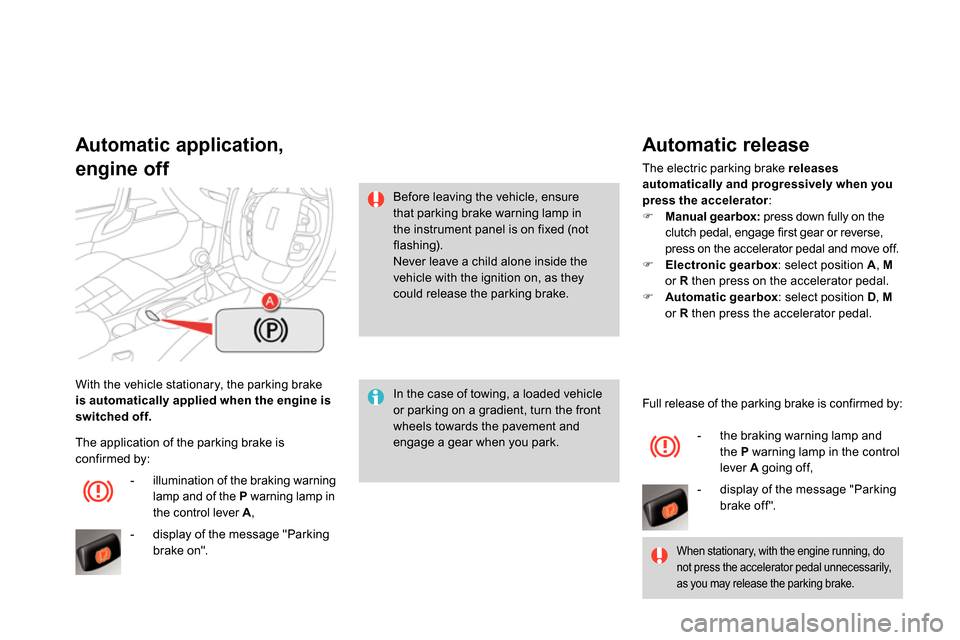
With the vehicle stationary, the parking brake
is automatically applied when the engine is
switched off.
Automatic application,
engine off
In the case of towing, a loaded vehicle
or parking on a gradient, turn the front
wheels towards the pavement and
engage a gear when you park.
Before leaving the vehicle, ensure
that parking brake warning lamp in
the instrument panel is on fixed (not
flashing).
Never leave a child alone inside the
vehicle with the ignition on, as they
could release the parking brake.
- illumination of the braking warning
lamp and of the P
warning lamp in
the control lever A
,
- display of the message "Parking
brake on". The application of the parking brake is
confirmed by:
Automatic release
The electric parking brake releases
automatically and progressively
when you
press the accelerator:
Manual gearbox:
press down fully on the
clutch pedal, engage first gear or reverse,
press on the accelerator pedal and move off.
Electronic gearbox
: select position A
, M
or R
then press on the accelerator pedal.
Automatic gearbox
: select position D
, M
or R
then press the accelerator pedal.
When stationary, with the engine running, do
not press the accelerator pedal unnecessarily,
as you may release the parking brake.
Full release of the parking brake is confirmed by:
- the braking warning lamp and
the P
warning lamp in the control
lever A
going off,
- display of the message "Parking
brake off ".
Page 199 of 400
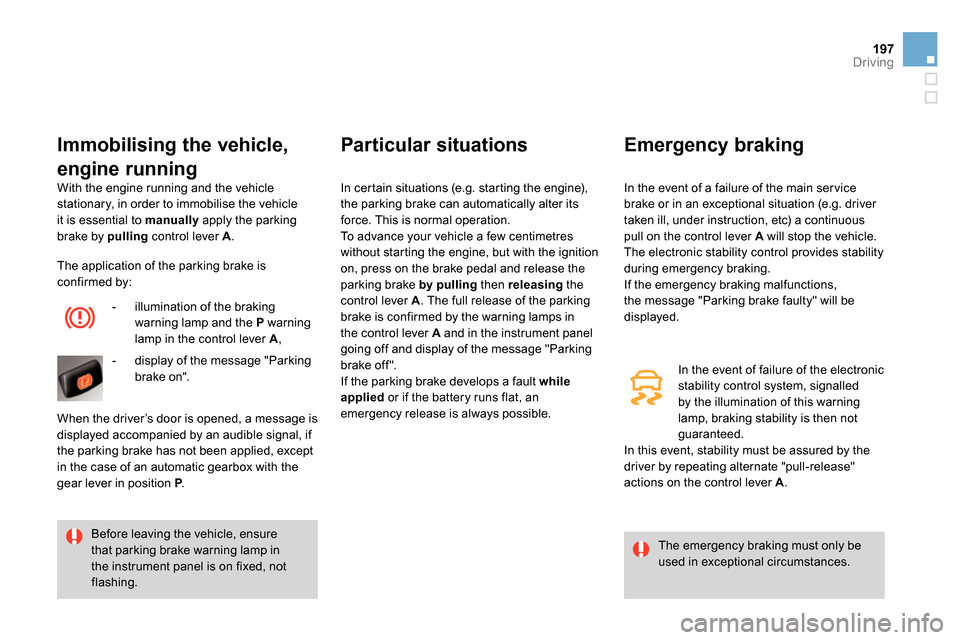
197Driving
With the engine running and the vehicle
stationary, in order to immobilise the vehicle
it is essential to manually
apply the parking
brake by pulling
control lever A
.
Immobilising the vehicle,
engine running
The emergency braking must only be
used in exceptional circumstances.
Before leaving the vehicle, ensure
that parking brake warning lamp in
the instrument panel is on fixed, not
flashing.
The application of the parking brake is
confirmed by:
- illumination of the braking
warning lamp and the P
warning
lamp in the control lever A
,
- display of the message "Parking
brake on".
When the driver’s door is opened, a message is
displayed accompanied by an audible signal, if
the parking brake has not been applied, except
in the case of an automatic gearbox with the
gear lever in position P
.
Particular situations
In certain situations (e.g. starting the engine),
the parking brake can automatically alter its
force. This is normal operation.
To advance your vehicle a few centimetres
without starting the engine, but with the ignition
on, press on the brake pedal and release the
parking brake by pulling
then releasing
the
control lever A
. The full release of the parking
brake is confirmed by the warning lamps in
the control lever A
and in the instrument panel
going off and display of the message "Parking
brake off ".
If the parking brake develops a fault while
applied
or if the battery runs flat, an
emergency release is always possible.
Emergency braking
In the event of failure of the electronic
stability control system, signalled
by the illumination of this warning
lamp, braking stability is then not
guaranteed.
In this event, stability must be assured by the
driver by repeating alternate "pull-release"
actions on the control lever A
. In the event of a failure of the main ser vice
brake or in an exceptional situation (e.g. driver
taken ill, under instruction, etc) a continuous
pull on the control lever A
will stop the vehicle.
The electronic stability control provides stability
during emergency braking.
If the emergency braking malfunctions,
the message "Parking brake faulty" will be
displayed.
Page 200 of 400
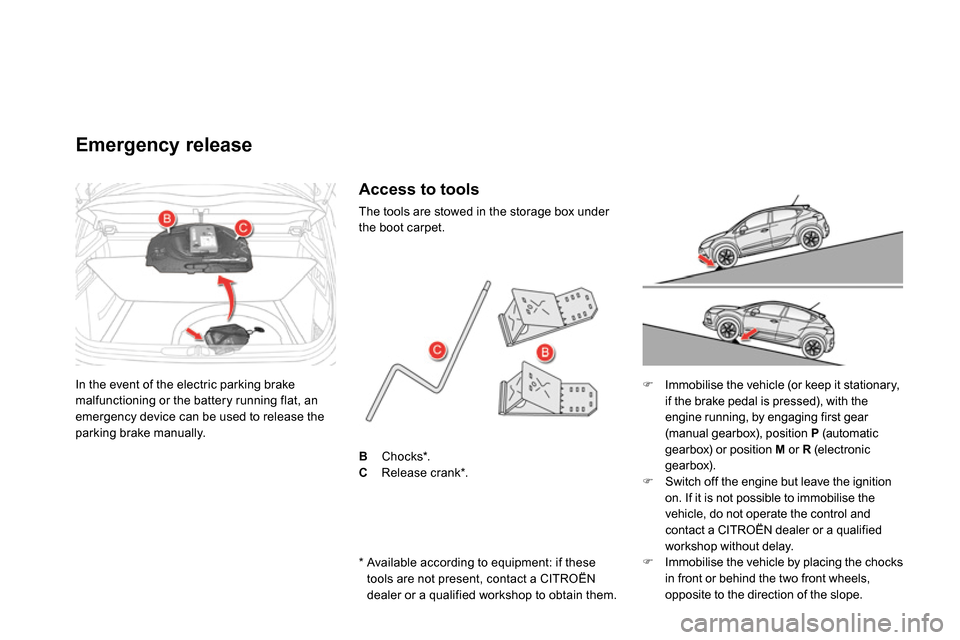
In the event of the electric parking brake
malfunctioning or the battery running flat, an
emergency device can be used to release the
parking brake manually.
Emergency release
Immobilise the vehicle (or keep it stationary,
if the brake pedal is pressed), with the
engine running, by engaging first gear
(manual gearbox), position P
(automatic
gearbox) or position M
or R
(elec tronic
gearbox).
Switch off the engine but leave the ignition
on. If it is not possible to immobilise the
vehicle, do not operate the control and
contact a CITROËN dealer or a qualified
workshop without delay.
Immobilise the vehicle by placing the chocks
in front or behind the two front wheels,
opposite to the direction of the slope.
Access to tools
The tools are stowed in the storage box under
the boot carpet.
B
Chocks*.
C
Release crank*.
* Available according to equipment: if these
tools are not present, contact a CITROËN
dealer or a qualified workshop to obtain them.
Page 201 of 400
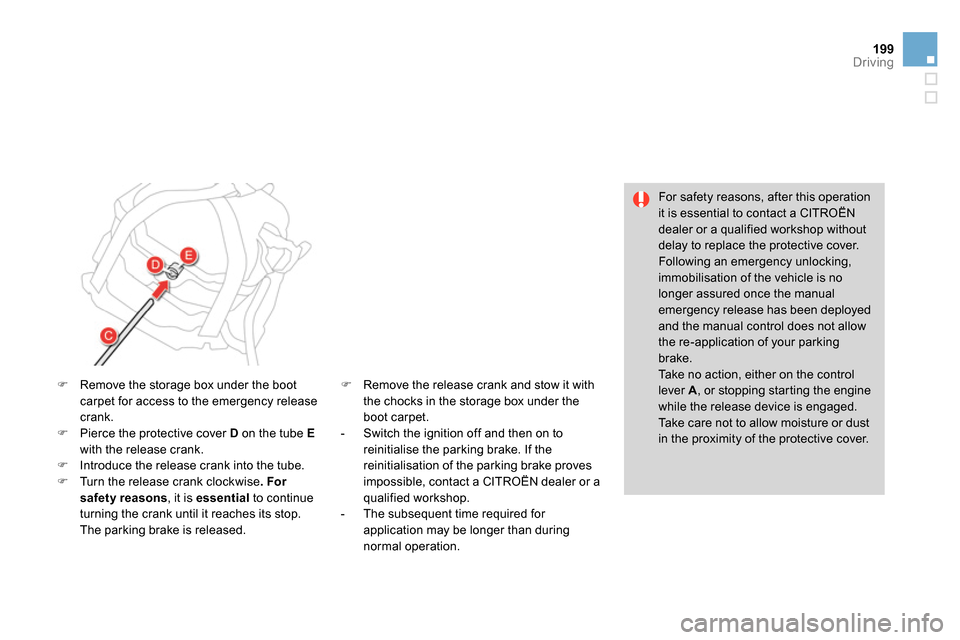
199Driving
For safety reasons, after this operation
it is essential to contact a CITROËN
dealer or a qualified workshop without
delay to replace the protective cover.
Following an emergency unlocking,
immobilisation of the vehicle is no
longer assured once the manual
emergency release has been deployed
and the manual control does not allow
the re-application of your parking
brake.
Take no action, either on the control
lever A
, or stopping starting the engine
while the release device is engaged.
Take care not to allow moisture or dust
in the proximity of the protective cover.
Remove the storage box under the boot
carpet for access to the emergency release
crank.
Pierce the protective cover D
on the tube E
with the release crank.
Introduce the release crank into the tube.
Turn the release crank clockwise .
For
safety reasons
, it is essential
to continue
turning the crank until it reaches its stop.
The parking brake is released.
Remove the release crank and stow it with
the chocks in the storage box under the
boot carpet.
- Switch the ignition off and then on to
reinitialise the parking brake. If the
reinitialisation of the parking brake proves
impossible, contact a CITROËN dealer or a
qualified workshop.
- The subsequent time required for
application may be longer than during
normal operation.
Page 203 of 400

201Driving
Situations
Consequences
To apply the electric parking brake:
immobilise the vehicle and switch off the ignition.
pull the control for at least 5 seconds or until application is complete.
switch on the ignition and check the switching on of the electric parking brake
warning lamps.
The application is slower than during normal operation.
To release the electric parking brake:
switch on the ignition.
pull the control and hold it for approximately 3 seconds then release it.
If the braking warning lamp is flashing or if the warning lamps do not come on with
the ignition on, these procedures will not work. Place the vehicle on level ground
and have it checked by a CITROËN dealer or a qualified workshop. and possibly
flashing
Display of the message " Parking brake fault
" and of the
following warning lamps:
- Only the automatic application on switching off the engine and automatic
release on acceleration functions are available.
- The manual application/release of the electric parking brake and the
emergency braking are not available.
and possibly
flashing
Battery fault
- If the battery warning lamp comes on you must stop immediately as soon as
the traffic allows. Stop and immobilise your vehicle (if necessary, place the
two chocks under the wheels).
- Apply the electric parking brake before switching off the engine.